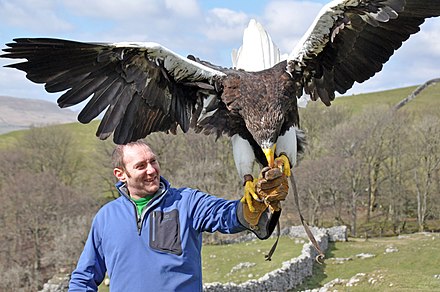Steller’s Sea Eagles are large birds of prey known for their impressive size, powerful talons, and sharp beaks. These majestic birds have evolved several adaptations to protect themselves from potential threats. From their keen eyesight to their aggressive behavior, Steller’s Sea Eagles employ a range of strategies to ensure their survival.
Keen Eyesight: Spotting Prey and Predators
One of the primary ways Steller’s Sea Eagles protect themselves is through their exceptional eyesight. These birds have the ability to spot fish from great heights, allowing them to dive at high speeds and catch their prey with precision. Their keen vision also enables them to detect potential predators and threats from a distance, giving them ample time to react and defend themselves.
Powerful Wings and Soaring Abilities
 Image source: stellers sea eagle
Image source: stellers sea eagle
Steller’s Sea Eagles possess strong, broad wings that allow them to soar effortlessly above their hunting grounds. This ability to glide and hover in the air not only helps them conserve energy but also makes it challenging for predators to catch them in flight. With a wingspan of up to 8 feet, these eagles can reach speeds of up to 50 miles per hour, further enhancing their ability to evade threats.
Aggressive Behavior and Territorial Defense
Steller’s Sea Eagles are known for their aggressive and territorial behavior. They fiercely defend their nesting sites and feeding areas from other eagles, as well as smaller predators such as ravens. These birds have been observed attacking and chasing away potential threats, using their sharp talons and powerful beaks to protect their domain.
Nesting Adaptations: Protecting the Young
Steller’s Sea Eagles build large, sturdy nests, known as aeries, in tall trees or on cliffs. These nests can be up to 5 feet deep and 8 feet in diameter, providing a secure and protected environment for their young. The size and placement of the nests help shield the eaglets from predators and harsh weather conditions, ensuring their survival during the critical early stages of their development.
Camouflage and Coloration
While not as prominent as their other adaptations, Steller’s Sea Eagles do exhibit some degree of camouflage and coloration that can help them blend in with their surroundings. Their dark brown plumage and white tail feathers can make them less visible to potential prey and predators, especially when perched on cliffs or in tall trees.
Adaptations to Harsh Environments
Steller’s Sea Eagles are found in the rugged and often harsh environments of northeastern Asia, including the coasts of Russia, Japan, and Korea. To survive in these challenging conditions, they have developed adaptations such as thick, insulating feathers and the ability to withstand extreme temperatures and weather conditions.
Threats and Conservation Efforts
Despite their impressive adaptations, Steller’s Sea Eagles face a range of threats, including habitat loss, pollution, and overfishing. These threats have led to a decline in their population, and the species is currently listed as vulnerable by the International Union for Conservation of Nature (IUCN).
To protect Steller’s Sea Eagles, conservation efforts are underway to preserve their habitat, monitor their population, and educate the public about the importance of these magnificent birds. By understanding and preserving the adaptations that help Steller’s Sea Eagles protect themselves, we can ensure the continued survival of this iconic species.
References:
– Owlcation: Birds of Prey – Steller’s Sea Eagle
– San Diego Zoo: Steller’s Sea Eagle
– Animalia: Steller’s Sea Eagle

